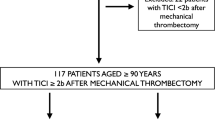Abstract
Introduction
Hypotension is common following carotid artery stenting (CAS), and may be mediated by vagal stimulation and/or suppression of spinal sympathetic outflow. Both mixed α/β agonists (dopamine (DA)), and more selective α- agonists (norepinephrine (NE) and phenylephrine (PE)), have been used, but the most effective treatment of post-CAS hypotension is unknown.
Materials and methods
We analyzed data for consecutive patients requiring vasopressor treatment of post-CAS hypotension. The treating physician made choice of vasopressor. Endpoints included infusion duration, coronary care unit (CCU) length of stay (LOS), and any major adverse events (death, stroke, myocardial infarction, arrhythmia).
Results
During the study period, CAS stenting was performed in 623 patients. CCU admission in atropine non-responders for vasopressor treatment was required in 42 patients (6.7%). DA was used in 20 patients (48%), NE in 13 patients (31%), and PE in nine patients (21%). Vasopressor infusion time was 31.8 ± 10.6 h for DA, compared with 23.8 ± 8.1 h for NE (P = 0.052) and 22.1 ± 6.1 h (P = 0.028) for PE. CCU LOS was 46.5 ± 14.1 h for DA compared with 36.9 ± 9.1 h for the NE and PE groups combined (P = 0.056). Major adverse events were more common in patients receiving DA than among patients receiving NE or PE (P = 0.04).
Conclusions
Compared with DA, treatment of post-CAS hypotension with a selective α-agonist (NE or PE) is associated with shorter drug infusion time, shorter CCU LOS, and fewer major adverse events.

Similar content being viewed by others
References
Mukherjee D, Yadav JS. Percutaneous treatment for carotid stenosis. Cardiol Clin 2002;20(4):589–97.
Yadav JS, Roubin GS, Iyer S, et al. Elective stenting of the extracranial carotid arteries. Circulation 1997;95:376–81.
Dangas G, Laird JR, Leon MB, et al. Post-procedural hypotension after carotid artery stent placement: predictors and short- and long-term clinical outcomes. Radiology 2000;215:677–83.
Brott TG, Adams HP, Olinger CP, et al. Measurements of acute cerebral infarction: a clinical examination scale. Stroke 1989;20:864–70.
Walter PF, Crawley IS, Dorney ER. Carotid sinus hypersensitivity and syncope. Am J Cardiol 1978;42:396–403.
Aviado DM, Schmidt CF. Reflexes from stretch receptors in blood vessels, heart, and lungs. Physiol Rev 1955;35:247–300.
Chapleau MW, Li Z, Meyrelles SS, et al. Mechanism determining sensitivity of baroreceptor afferents in health and disease. Ann NY Acad Sci 2001;940:1–19.
Boyce JR, Peters GE. Complete vasomotor collapse; An unusual manifestation of the carotid sinus reflex. Anesthesiology 2003;98:1285–7.
Sanders JS, Ferguson DW. Diastolic pressure determines autonomic responses to pressure perturbations in humans. J Appl Physiol 1989;66:800–7.
Fan W, Reynolds PJ, Andresen MC. Baroreflex frequency response characteristics to aortic depressor and carotid sinus nerve stimulation in rats. Am J Physiol 1996;271:H22218–27.
Shoukas AA. Overall systems analysis of the carotid sinus baro-reflex control of the circulation. Anesthesiology 1993;79:1402–12.
Wong JH, Findlay JM, Suarez-Almazor ME. Hemodynamic instability after carotid endarterectomy: risk factors and associations with operative complications. Neurosurgery 1997;41:35–43.
Riles TS, Kopelman I, Imparato AM. Myocardial infarction following carotid endarterectomy; a review of 683 operations. Surgery 1979;85:249–52.
North American Symptomatic Carotid endarterectomy Trial Collaborators. Beneficial effect of carotid endarterectomy in symptomatic patients with high grade carotid stenosis. NEJM 1991;325:445–55.
Chio FL, Liu M, Khan M, et al. Effectiveness of elective stenting of common carotid artery lesions in preventing stroke. Am J Cardiol 2003;92:1135–7.
Kasirajan K, Matteson B, Marek J, et al. Comparasion of non-neurological events in high risk patients treated by carotid angioplasty versus endarterectomy. Am J Surg 2003;185:310–4.
Chaturvedi S, Fessler R. Angioplasty and stenting for stroke prevention. Good questions that need answers. Neurology 2002;59:664–8.
Mendelsohn F, Weissman NJ, Lederman RJ, et al. Acute hemodynamic changes during carotid artery stenting. Am J Cardiol 1998;82:1077–81.
Nandalur KR, Hardie AD, Raghavan P, et al. Composition of the stable carotid plaque: insights from a multidetector computed tomography study of plaque volume. Stroke 2007;38(3):935–40.
Theron J, Raymond J, Casasco A, et al. Percutaneouis angioplasty of atherosclerotic and post-surgical stenosis of carotid arteries. Am J Neuroradiol 1987;8:495–500.
Trocciola SM. Analysis of parameters associated with hypotension requiring vasopressor support after carotid angioplasty and stenting. J Vasc Surg 2006;43(4):714–20.
Harrop JS. Prevention of carotid angioplasty-induced bradycardia and hypotension with temporary venous pacers. Neurosurgery 2001;49:814–20.
Wholey MH, Jarmolowski CR, et al. Endovascular stents for carotid artery occlusive disease. J Endovasc Surg 1997;4:326–8.
Angell-James J, Lumley JSP. The effects of carotid endarterectomy on the mechanical properties of the carotid sinus and carotid sinus nerve activity in atherosclerotic patients. Br J Surg 1974;61:805–10
Pine R, Avellone J, Hoffman M, et al. Control of post carotid endarterectomy hypotension with baroreceptor blockade. Am J Surg 1984;147:763–5.
Acknowledgements
Conflict of interest No conflict of interest exists for this project. There are no financial associations and no funding was required. The only institutional association is with the Medstar Research Insitute, a division of Medstar Health and Washington Hospital Center.
Author information
Authors and Affiliations
Corresponding author
Rights and permissions
About this article
Cite this article
Nandalur, M.R., Cooper, H., Satler, L.F. et al. Vasopressor Use in the Critical Care Unit for Treatment of Persistent Post-carotid Artery Stent Induced Hypotension. Neurocrit Care 7, 232–237 (2007). https://doi.org/10.1007/s12028-007-0073-1
Published:
Issue Date:
DOI: https://doi.org/10.1007/s12028-007-0073-1




